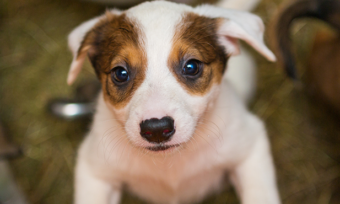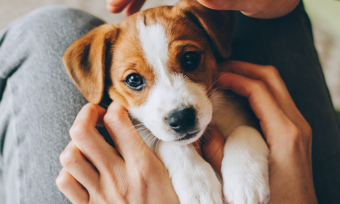Kiwi vet, Dr Cath Watson explains what vets look at during routine check-ups.
Step 1: General Observation
First up, your vet consult will probably start with a general observation. They’ll look at your pet’s overall condition, like how they’re standing, moving, and behaving. It’s like a quick once-over to get a sense of their general health and wellness.
“We’re making sure everything is looking pretty good and healthy,” says Dr Watson. “It starts when they first come in the room – we’re looking at how they’re moving, what they look like, what their weight is like…”
They’ll also take this opportunity to make sure your pet is comfortable.
“Some pets are really worried about coming into the vet consult room and are quite anxious,” says Dr Watson. “So sometimes your vet might spend a bit of time talking to you and you can let your pet have a wander around the room and just feel a little bit more comfortable about how things are going.”
A relaxed pet is much easier to do a vet checkup on than an anxious pet!

Step 2: Nose
During the vet check-up, they may check your pet’s nose. This is because the nose can tell a lot about your pet’s overall health. A healthy nose is usually moist, not too dry or too wet. If the nose is excessively dry, cracked, or has unusual discharge, it could indicate health issues like dehydration, infections, or even allergies in your cat or dog.
The vet may also look at the colour of the nose during the vet consult. But contrary to popular belief, the temperature doesn’t tell them much:
“The temperature of the nose tends to reflect more what the environmental temperature is, rather than anything particularly wrong with your dog or cat,” says Dr Watson.
While a warm, dry nose doesn’t automatically mean your pet is sick (this is a common myth!), any significant changes from their normal state can be a clue for the vet. For example, a very pale or very red nose might signal problems with blood circulation or other health issues.
Step 3: Eyes
Next, your vet may look at the clarity and brightness of the eyes. Clear, bright eyes are usually a good sign. If there’s cloudiness, excessive tearing, or redness, it might suggest problems like pet eye infections, allergies, or even more serious health issues.
“They eyes should be nice and open and clear with no discharge and no staining of the fur running down from the corners of the eyes,” says Dr Watson. “There should be no lumps or bumps or anywhere.”
The vet also checks how your pet’s pupils react to light. They should respond consistently – if they don’t, it could indicate neurological issues or problems with the eye itself.
The area around the eye is important too. Swelling, discharge, or crustiness can be signs of infection or other issues.
Step 4: Ears
Firstly, your vet is checking for cleanliness and any signs of a cat or dog ear infection. Healthy ears should be relatively clean and not have a bad smell. If there’s a lot of wax build-up, redness, or an unpleasant odour, it might suggest an ear infection, which is pretty common in pets, especially dogs.
Then, the vet looks for any signs of parasites like ear mites, which can cause irritation and inflammation. Ear mites are quite tiny, but their presence can lead to significant discomfort for your pet.
In a nutshell, the vet is ensuring your pet’s ears are healthy and not showing signs of problems. It’s a key part of the check-up, helping them spot any issues early on. Healthy ears are crucial for a happy, comfortable pet.
Step 5: Teeth
Here the vet checks for signs of dental problems like tartar build-up, gum disease, or broken teeth. Dental issues are quite common in pets and can lead to more serious health problems if left untreated. Healthy teeth and gums are essential for your pet’s ability to eat properly and comfortably, not to mention their gut health.
Then, the vet looks at the gums. Healthy gums should be pink and firm, not red, swollen, or bleeding. Changes in gum colour or condition can indicate issues like anemia or infection. Read our tips for looking after cat teeth and all about dog teeth cleaning to keep your pet’s pearly whites in tip-top shape.
The vet also checks for any unusual lumps, bumps, or lesions in the mouth, which could be signs of oral diseases or even tumours.
In addition, they might check your pet’s breath. Bad breath can sometimes be a clue to underlying health issues, not just dental problems.
Step 6: Lymph Nodes
Next up in the vet consult, the lymph nodes.
“This is what we refer to in humans as glands,” says Dr Watson. “These are the organs that often end up a bit enlarged whenever there’s inflammation around.”
Lymph nodes are small, bean-shaped structures that are part of the immune system. They’re scattered throughout the body, with some of the main ones being under the jaw, in the armpits, and behind the knees. When your pet is healthy, these nodes are usually hard to feel because they’re small and not swollen.
Your vet feels these nodes to check their size and texture. If they’re enlarged or feel unusual, it could be a sign that your pet’s body is fighting off an infection or inflammation. Sometimes, enlarged lymph nodes can also be a sign of more serious conditions, like lymphoma or other cancers.
Step 7: Skin
Your vet will check for any signs of skin problems like dryness, oiliness, dandruff, lumps, bumps or unusual spots. These could indicate issues like allergies, cat or dog skin conditions, hormonal imbalances, or even parasites such as fleas.
They’ll also look at the coat. A healthy coat should be shiny and smooth, not brittle or patchy. Changes in the coat can signal nutritional problems or underlying health issues.
The vet will also be feeling around for any lumps or bumps under the skin. These could be anything from harmless cysts to more serious growths. It’s really important to catch these things early.
In addition, they’ll check for any signs of irritation or scratching. Excessive scratching can lead to skin damage, and it’s often a sign that something’s not quite right, whether it’s fleas, allergies, or something else.
Step 8: Stomach
Next up during the vet consult, you may see them pressing on your pet’s stomach.
“I call it tummy massage, but we’re having a feel of the organs inside the tummy and working from front to back,” says Dr Watson.
Your vet feels your pet’s abdomen to check the size, shape, and texture of the internal organs. They’re feeling for any unusual lumps, bumps, or areas of discomfort that could indicate problems like masses, organ enlargement, or fluid build-up.
They also check to see if your pet shows any signs of pain or discomfort during this examination. This can be a clue to issues like inflammation, infection, or other internal problems.
This tummy check can give insights into the health of organs like the liver, spleen, kidneys, intestines, and bladder. Each of these organs can be affected by various health conditions, and abnormalities can often be detected through a physical examination.
It’s a bit like checking under the bonnet of a car – your vet is making sure everything inside is running smoothly and there aren’t any warning signs of trouble.
Step 9: Joints
“If there’s any reports of lameness or the client thinks there might be a problem with the way their pet is moving, then we might progress on to checking how the joints are working,” says Dr Watson.
Firstly, your vet is looking for signs of arthritis or joint pain. This is particularly common in older pets, but it can affect younger ones too, especially certain breeds or those with previous injuries. They’ll gently feel and move your pet’s legs, checking for any stiffness, swelling, or discomfort.
They’re also checking the range of motion in the joints. Healthy joints should move freely and without pain. If your pet resists certain movements or shows signs of discomfort, it might indicate joint problems.
Your vet will also observe how your pet walks and stands. They’re looking for any limping, reluctance to move, or difficulty getting up and down, which can all be signs of joint issues.
Step 10: Tail
Your vet checks your pet’s tail for any signs of injury, skin problems, or parasites like fleas. They also look for any abnormalities in how your pet carries or moves their tail, which can indicate pain or neurological issues.
Then, under the tail. This is where your vet checks your pet’s bottom, including the anal area. They’re making sure everything looks normal and healthy. No swelling, no sores, and no signs of discomfort or pain.
This is also where they check the anal glands, which are small glands located on either side of your pet’s anus. These glands can sometimes become impacted or infected, which is uncomfortable for your pet and can lead to bigger issues if not addressed.
Plus, in this area, they’re looking for signs of digestive health. Problems like diarrhoea or constipation can often be spotted here.
So, when your vet checks your pet’s tail and under the tail, they’re making sure everything in this often-overlooked area is in good shape. It’s about ensuring your pet’s comfort, hygiene, and spotting potential issues early on. It’s a bit less glamorous than other parts of the vet consult, but it’s just as important for keeping your pet healthy and happy.
Step 11: Heart
Next, your vet will check your pet’s heartbeat.
“There are two things I do here.” says Dr Watson. “One’s to put the stethoscope on the chest and have it listen to the heart. And at the same time, I’m going slide my hand back inside their thigh to have a feel of the pulse to make sure that their heart is beating at the same time as they’re pumping blood around the body.”
By comparing the heart sounds and the pulse, the vet can spot any discrepancies. If the heart’s rhythm doesn’t match the pulse’s rhythm, it could indicate a problem with the heart’s ability to effectively pump blood. This could be a sign of heart disease or other circulatory issues.
They also listen for any unusual sounds, like murmurs. A heart murmur is an extra or abnormal sound during the heartbeat. Some murmurs are harmless, but others can be signs of heart issues that need further investigation.
This heart check helps the vet to spot any early signs of heart problems, which is especially important as pets get older. Early detection can make a big difference in managing heart conditions and keeping your pet healthy.
Step 12: Lungs
Using a stethoscope, your vet may then listen to the sounds of your pet’s lungs and chest as they breathe in and out. They’re listening for clear, normal breathing sounds. Any crackles, wheezes, or unusually loud or quiet breathing can be clues to underlying issues.
Abnormal sounds in the lungs can indicate a range of problems, like infections (e.g. pneumonia), asthma, allergic reactions, or even heart problems that can affect the lungs. The vet is also checking for any signs of fluid in the lungs or chest, which can be serious.
Besides the lungs, the vet is also assessing the overall respiratory effort. They look at how your pet is breathing – whether it’s relaxed and easy or if your pet seems to be struggling or breathing rapidly. Difficulty breathing can be a sign of distress or disease.
This part of the vet consult helps them to catch any early signs of respiratory problems, which is especially important because issues like infections or asthma can get worse quickly if not treated.
Compare pet insurance providers here!
About the reviewer of this page
This report was reviewed by Canstar Content Producer, Caitlin Bingham. Caitlin is an experienced writer whose passion for creativity led her to study communication and journalism. She began her career freelancing as a content writer, before joining the Canstar team.
Enjoy reading this article?
You can like us on Facebook and get social, or sign up to receive more news like this straight to your inbox.
By subscribing you agree to the Canstar Privacy Policy





Share this article